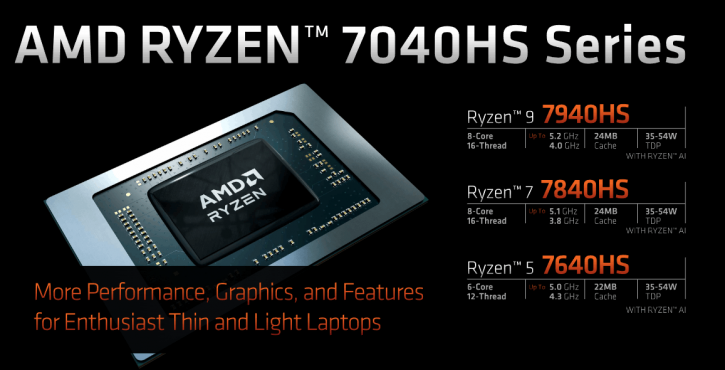Introduction
Razer Blade 14 (Ryzen 9 7940HS) review
Unleashing the Power of Ryzen 9 7940HS (8c/16t) and GeForce RTX 4070
A good two years ago Razer introduced the Blade 14 series, a collection of 14-inch laptops designed for portability without sacrificing performance. A distinctive feature of the series is the usage (option) of AMD Ryzen processors, a deviation from the common practice of utilizing Intel Core. The inaugural models were launched with AMD Ryzen 5000 processors (Cezanne APUs), which were updated in the subsequent year to the more advanced Ryzen 6000 (Rembrandt APUs). Concurrently, the laptops were equipped with NVIDIA GeForce RTX 3000 Ampere generation graphics, with expectations for a significant upgrade in the future. Razer now provided us with the refreshed version of the Blade 14 laptop, employing the all-new AMD Ryzen 9 7940HS (Phoenix APU) processors and NVIDIA GeForce RTX 4000 Laptop GPUs, with an option to select the GeForce RTX 4070 Laptop GPU. Given the assumption that Razer maintains the same TGP (Total Graphics Power), the GPU's power limit is projected to be capped at 140 W. There is also positive anticipation for more economical versions featuring other Zen 4 processors like the Ryzen 5 7640HS and Ryzen 7 7840HS, and the NVIDIA GeForce RTX 4050 Laptop GPU or the GeForce RTX 4060 Laptop GPU. Razer Blade 14 models have traditionally employed state-of-the-art cooling technology, such as steam chambers, to manage heat dissipation efficiently. Notably, Razer laptops have garnered praise for their effective equilibrium between mobility and battery performance, barring dGPU usage. Of course, this review is mainly focussed at platform and processor performance. You're probably not purchasing a 140 TGP-based integrated GPU and expect god battery life while gaming.
The Ryzen 7940HS series, inclusive of Phoenix, integrates AMD's power management systems derived from the Ryzen 6000 Rembrandt mobile processors. Despite falling within the 35-54 W TDP range, notebooks utilizing the 7940HS series can sustain up to 9 hours of video playback on a single charge, as evidenced by tests conducted on the Razer Blade 14.
The AMD Ryzen 9 7940HS is a 45-watt class CPU, and that TDP is flexible these days (we'll explain later), placed beneath the HX CPUs such as the Ryzen 9 7945HX in terms of hierarchy. Distinct variations exist in the technical specifications of these CPUs. Both versions utilize Zen4 cores; however, the HX variant incorporates a chiplet design (Dragon Range, 5 nm), which involves individual manufacture and subsequent assembly of the processor components. The HS chips are developed via a 4 nm process and include the latest iGPU Radeon 780M based on the RDNA3 architecture, integrated with AMD's latest Radiance Display Engine. This engine extends hardware compatibility to DisplayPort 2.1 and HDMI 2.1a. Furthermore, the iGPU is enhanced with AMD's latest media acceleration functionalities, incorporating a Dual Media Accelerator. This accelerator includes two hardware accelerators, each equipped to handle encoding or decoding tasks, extending support for the AV1 format.
A hint of Ryzen AI
Ryzen AI operates as a standalone hardware element, separate from the CPU and iGPU. It functions as an on-chip AI accelerator, allowing software to execute an array of AI-optimized tasks commonly employed by consumers, such as image manipulation, video conferencing enhancements, local media sorting, and locally-based GPTs like Office Co-pilot. As it stands, Microsoft is incorporating Ryzen AI-accelerated features into Windows 11 and Office. By the conclusion of 2023, AMD projects an influx of various OEMs, ISVs, and key third-party software developers to be involved in an ecosystem that leverages the capabilities of Ryzen AI. Currently, the accelerator supports ONNX and TensorFlow models. In parallel, AMD is also designing the AMD Unified AI Stack, a compilation of APIs that allow software to utilize the power of not just the Ryzen AI accelerator but also the AI-relevant ISA introduced with Zen 4 encompassing AVX-512, bfloat16, and VNNI. This methodology implements an extensive strategy towards AI acceleration by harnessing the AI Accelerators embedded within the iGPU's RDNA3 compute units. Incorporating Ryzen AI reduces dependency on cloud-based AI services.
| Razer Blade 14 2023 | |
| Display | 17.3-inch, 16:9, non-touch, matte,QHD+ 2560 x 1600 px, IPS, 240 Hz, 500-nits |
| Processor | AMD Phoenix Range HX, Ryzen 9 7940HS, 8C/16T |
| Video | Radeon 780M +Nvidia GeForce RTX 4070 (up to 140W with Dynamic Boost), GSync |
| Memory | 16GB DDR5-5600 DRAM / up to 64 GB (2x DIMMs) |
| Storage | 1TB SSD |
| Connectivity | WiFi 6E 2×2 with Bluetooth 5.2 |
| Battery | 19.5A, 230W power adapter |
As per AMD, the HS CPUs are within a TDP (Thermal Design Power) bracket of 35-54 watts. Test demonstrated power consumption of up to 90 watts. The implications of this discrepancy will be discussed later. The Ryzen 9 7940HS comprises eight full Zen4 cores operating at a base clock rate of 4.0 GHz, with a maximum Turbo clock rate of 5.2 GHz in single-core benchmarks. The I/O configurations of AMD's Phoenix processor are quite akin to its Dragon Range flagship series. Phoenix supports dual-channel DDR5 and LPDDR5 memory, divided into four sub-channels. However, Phoenix's PCI-Express interface operates at Gen 4. The primary PEG interface aligns with PCI-Express 4.0 x16, with the CPU-attached M.2 NVMe slot functioning at Gen 4 x4.



